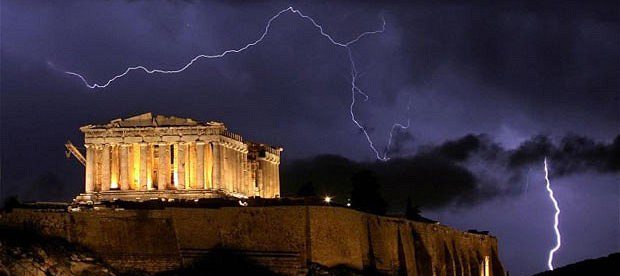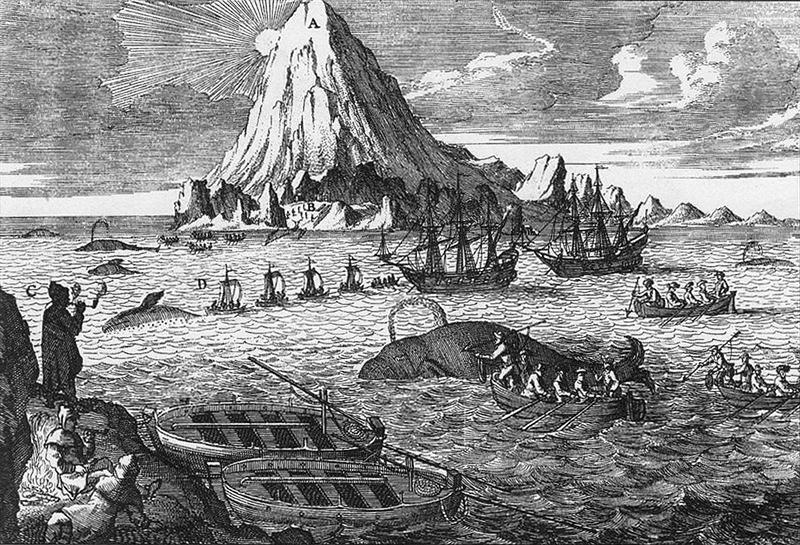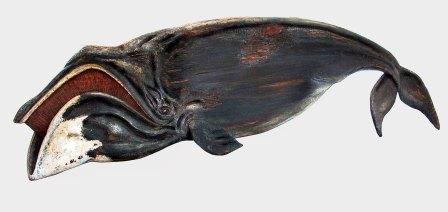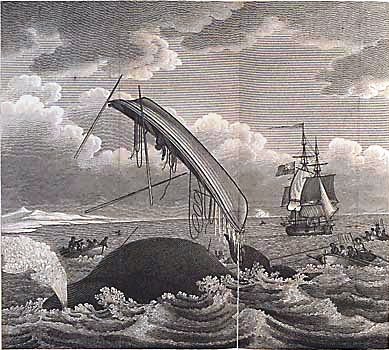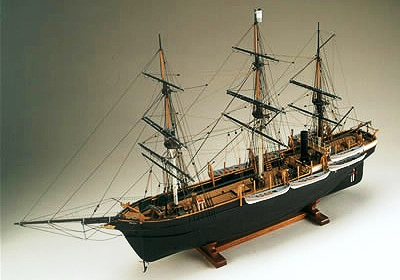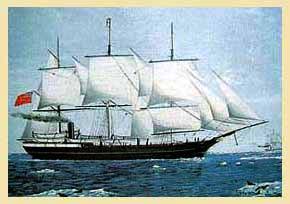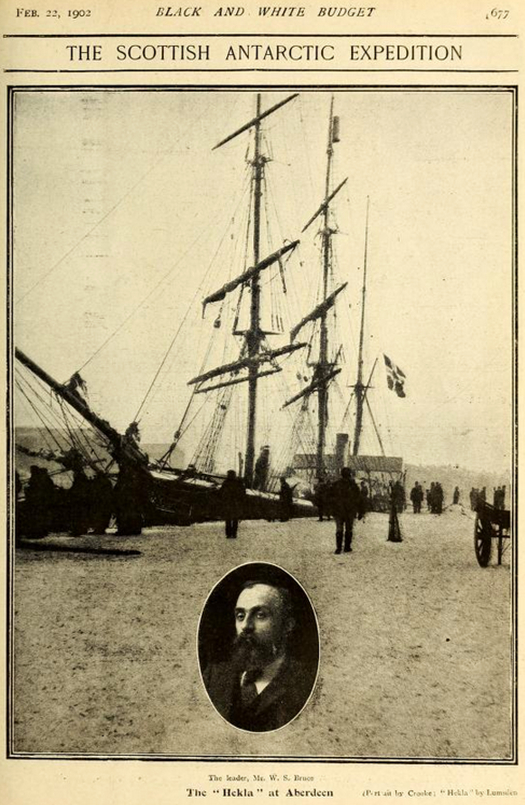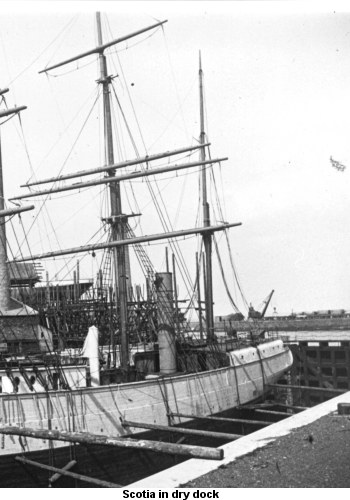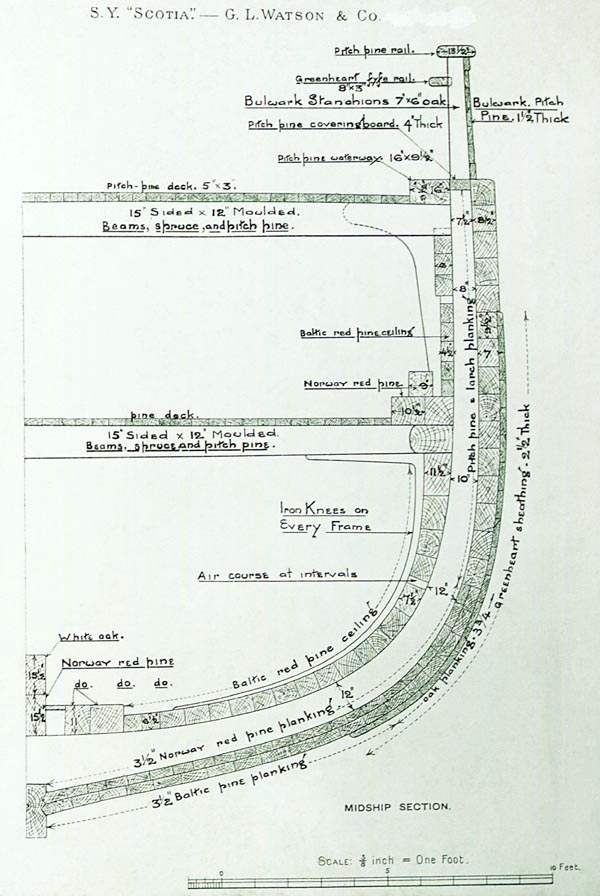Whaling Industry in Aberdeen
Whale-Fishing was 1st introduced into Aberdeen in the year 1753, and the success which attended the 1st Attempts induced others to Embark in the same Trade, which, for a time, was very Profitable. Accordingly, the number of Ships from Aberdeen engaged in Whale-Fishing gradually increased, till, in 1820, there were 15-Whaling Ships, which, on an average, had about 50-hands each. The greatest Tonnage of Oil brought, home by these Vessels in 1-Season was in 1823 when 14-Vessels brought 1841-Tonnes. Of later years, however, from various causes, such as the withdrawing of the Government Bounty, the reduction of the Duty on Foreign Seeds from which Oil could be pressed, the diminished demand for Oil, of late, in consequence of the Introduction of Gas as a means of obtaining Light, and the want of success in the Fishery, several Vessels having repeatedly come home clean, the Trade has been, in a great measure, given-up & there were only 2-Vessels engaged in it from this Port. In the 18thC, the Fishing Industry in Aberdeen centred mainly on River & Salmon Fishing. In 1820, 15-Vessels from Aberdeen were engaged in the Northern Whale & Seal Fishing; in 1860, only 1-Vessel, but none since. Aberdeen’s Whaling Industry was 2nd to that of Peterhead.
Aberdeen Vessels Sailed on Whaling Expeditions to the Arctic in the 18th & 19thC. The Bowhead or Greenland Right Whale was hunted for its Blubber which was Boiled down to produce Lamp Oil. Whalebone was used in Dressmaking. There was lots of money to be made but it was dangerous. Sometimes no Whales were caught or Ships were Crushed by Ice & their Crews Lost. By the 1830s, Overfishing had greatly reduced the number of Whales.
In the 17thC, Whales were still to be seen lolling on the surface of the deep without any sense of danger from Hunters. Consequently, the number of Whalers became so great that the Whales, being pursued & killed in vast numbers, making a Desert of their Native Seas. They were followed Northward by their relentless Pursuers, into the heart of the Frozen Fields, where Fishing became so hazardous an undertaking that the number of Ships rapidly began to decrease. In 1730, 25-British Vessels went out & returned with only 12-Whales; in 1775, – 105 were sent out but met with ill-success. Notwithstanding the Government Bounty, in 1781 the number fell to 39 & the lowest depression in this Early Industry was touched. From that date through the introduction of larger & more Modern Vessels & Co-operative Action, it again prospered and was on the ascendancy when Peterhead 1st entered the Lists as a Whaling Port.
Seal & Whalers, Peterhead c.1877
Cumberland Gulf Whale Fishing Co. 19-Harbour Street Peterhead – William Baxter, Manager
Eclipse Steam Seal & Whale Fishing Co. 19-Harbour Street Peterhead, David Gray, Manager
Hope Steam Seal & Whale Fishing Co. 56-Broad Street – Robt Kidd, Manager
Hudson’s Bay Co. (The) 35-Broad Street; W & W A Alexander, Agents
Mazinthien Steam, Seal & Whale Fishing Co. 19-Jamaica Street; Jas Reid, Manager
Old Whale Fishing Co. 35-Broad Street; W A Alexander, Manager
Peterhead Seal Fishing Co. 18-Harbour Street – Alex. Robertson, Manager
Polar Star & Windward Fishing Ships, 9-Shiprow – W Mitchell, Manager
Resolution Seal & Whale Fishing Co. 18-Harbour St. Alexander Robertson, Manager
Xanthus & Alert Whale Fishing Ships, 77-Queen Street… Hutchison & Macbean, Agents
Peterhead, with 31-Active Ships, was the Country’s Principal Whale-blubber Port. The Town’s 1st Ship, the ‘Robert‘, a modest ‘2-Master’, offered the Southern Traders little competition, in fact after 10-lean years under English Captains Harrison & then Peacock, her Owners were on the verge of closing down Business when 2 of the Principal Shareholders, John Hutchison & James Arbuthnot, made a last-minute bid to save their Investment by suggesting the Ship be put in the hands of a Local, perhaps more diligent, Skipper & Crew. Sandy Geary (Garioch), a Sailor’s son from the old Roanheads, was promoted to Captain on the recommendation of his Shipmates & brought a sudden change of Fortune to the Ship. On her 1st Trip under Geary, the ‘Robert‘ took 8–Whales & brought home more than 70-Tonnes of Oil (worth £2,000 — a Fortune in 1798).

In 1802 the Robert was replaced by the Hope, a Vessel of 240-Tons, under the same Commander. (1873 Built by Hall & Co, Aberdeen for Captain John Gray of the Hope Seal & Whale Fishing Co Registered at Peterhead. Engines 2-Compound Inverted direct-acting, 70HP, from Gourlay Bros. Dundee Length 149′ x Breadth 28′-1″ x Depth 17′ Gross Tonnage 307-Tons.
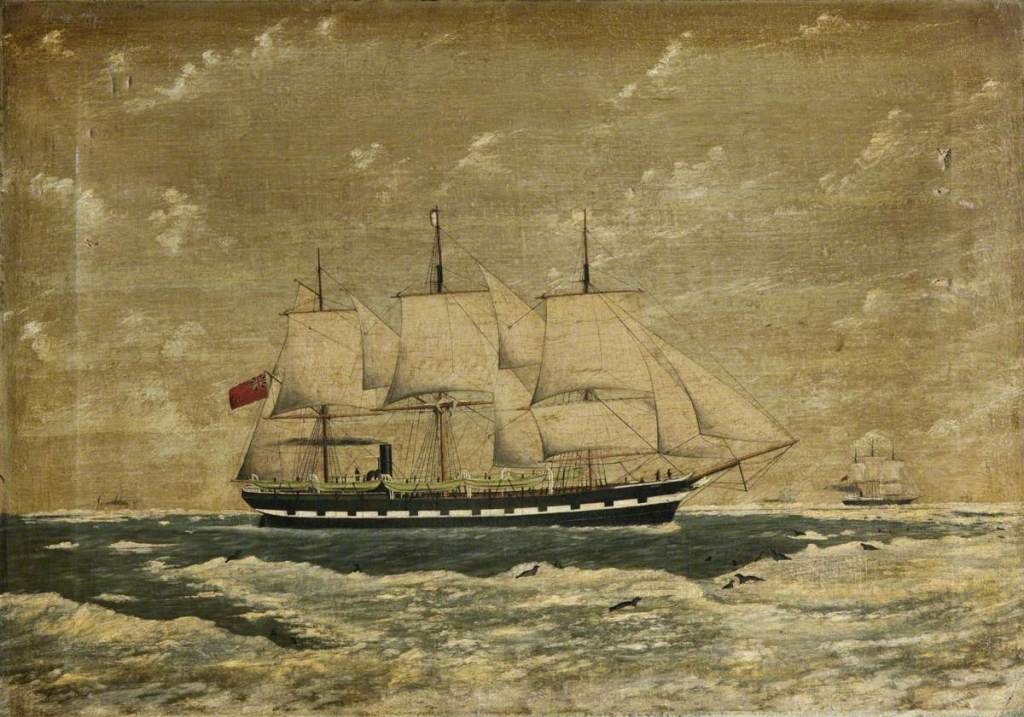

Sister Ship Eclipse 1867 Built by A Hall & Co, Aberdeen for Captain David Gray, Master & Shipowner. Registered at Peterhead.) The reasons for this change require a little explanation. In 1732 Great Britain attempted to encourage the Whale Fishery by a Bounty of 30s a Ton to every Ship of 200-Tons engaged in it, which was raised in 1749 to 40s, reduced to 30s in 1777 & again raised to 40s in 1781. The object of the Bounty was not only to encourage the Trade but also to make it a Nursery for Hardy Seamen. Ships, however, were sometimes fitted out rather for the Bounty than for the Capture of Whales & so the Bounty was again reduced & finally altogether withdrawn in 1824.
The Robert, being under 200-Tons, was ineligible for this Bounty, but the Hope received it. It was Guaranteed by Government & amounted to £480 for every Voyage it made – that is, at 40s per Tonne – no mean relief, to say nothing of the Vessel being larger & more suited to the Industry. This money from Government was a consideration& those Vessels which could not lay claim to it were heavily handicapped in their efforts. In 1801 the Active, 308-Tonnes, under Captain J Sutter, joined the pursuit of the Whale from Peterhead, and in the following year, the Perseverance, 240-Tons, under Captain D Gray, was added to the little Fleet. In 1804 the Enterprise, 290-Tonnes, under Captain W Volum, also joined up. In 1811, 122–Whales were caught, yielding 752-Tonnes of Oil, this being an average for the 4-Vessels of 188-Tonnes. In 1813 the Resolution & the Union joined the Peterhead Whaling Fleet, and the following year the Dexterity. The year 1814 is ever to be remembered in the Annals of Peterhead Whale Fishing.
February 1880 Arthur Conan Doyle, while a 20-yr-old Medical Student at Edinburgh University, enlisted as Surgeon for a 7-month Whaling Trip to the Arctic Circle. His Journal is reproduced in the Book ‘Dangerous Work; Diary of an Arctic Adventure‘ Published by the British Library. He observes “Hillocks” of Ice “rising & falling with the waves, pure white above and of a wonderful Green below.” Also included is Doyle’s 2-page Listing of all the Animals – from Protozoa to Right Whales he saw during the Journey, which lasted from February through August. Captain Gray was so impressed by Conan Doyle that on their return to Port he offered him the chance to return for the following Season’s Voyage, to work as a Harpooner as well as a Surgeon, but the younger man turned him down. “It is well I refused,” he later said, “for the life is dangerously fascinating.”
1868, 17th April: The Buchan Observer & East Aberdeenshire Advertiser, reported as follows:
“The Davis Straits Whale Fishing. The ‘Xanthus’, Captain Milne, Sailed for this Fishing on Saturday. The Vessel has been fitted with a Donkey Engine of about 8-HP, by the Messrs Leckie, Shipbuilders Aberdeen. The estimated cost was, we believe, £250. The ‘Perseverance’ is the only other Vessel now in the Harbour intending to go to the Whale Fishing. She will Sail in about a week.”
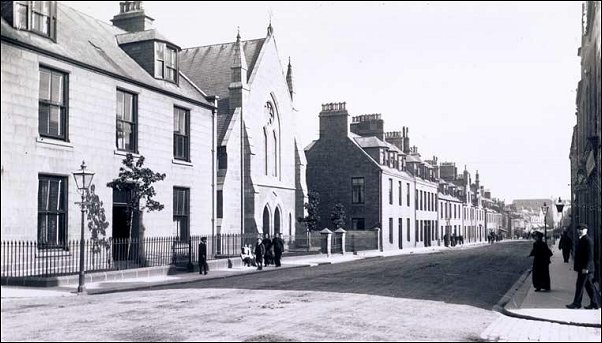
Clifton House, situated in Clifton Road, Peterhead was the home of Captain John Gray Jnr of the Whaling Ships Queen, Mazinthien & Hope. Peterhead sent out her 1st Whaler, the Robert in 1788. In April 1893 Captain David Gray (III) came out of retirement and took the Windward North. In August he returned with the blubber of a single Whale – the Peterhead Whaling Industry was at an end. However, for a few decades in the middle of the 19thC, Peterhead had been the premier Whaling & Sealing Port in the British Isles and had enjoyed great prosperity.
Aberdeen used to be a big centre for Whaling. Ships 1st Sailed from here to the Arctic Ocean in 1752. In the year 1752, a Company was Instituted at Aberdeen for Establishing the Whale Fishing Business. Many Citizens engaged in Commerce & several Gentlemen of the County, became Partners & raised a Capital Stock of £8,000 Sterling, in Shares of £50 each, for the purpose of carrying on the Undertaking. The affairs of the Company were conducted by a Committee of Management, chosen by the Partners. Two Large Ships were fitted out in the Spring of the year 1753 & Sailed to the Greenland Seas, one of them being called the Saint Ann (Captain Lang) & the other the City of Aberdeen (Captain Park), of the burthen of 500-tons. They returned from the Fishing in the end of July, the former with 5-Whales & the latter with 2. In the subsequent year they went upon a similar Voyage, but were not so successful, for the Saint Ann sustained considerable Damage from the Ice & was obliged to return without any Catch & the other Ship brought home only 2-Whales in the month of July. They never proceeded upon another Voyage in the Whaling Business, but were Sold & the Company dissolved, after having sunk a great part of their Capital. In the year 1783, another Whale Fishing Company was Established, who fitted out 2-Vessels, called the Hercules (Captain McLaren) & Latona (Captain Storey). They persevered in the Business for several years, with various Degrees of success, but ultimately it proved a very good concern. There are now 5 Established Companies! in Aberdeen, who Employ altogether 14-Ships in Whale Fishing, the cumulo tonnage of which is 4379 Register measure, the number of hands on board of them being about 700.
Whales have a lot of body fat, called Blubber. Blubber was Boiled to make Lamp oil sometimes known as “Train Oil“. In the past, there was no Gas or Electricity & people used Oil lamps. In Aberdeen the Boiling of Blubber was carried out in Footdee. A Boilyard existed in York Street. A Number of Boilers were sited in the Fishing Village Squares – 4 in North Square, 3 in South Square & none in Pilots Square. The Blubber was Boiled in Copper Vessels of up to 10-tonnes or more capacity. These were Round in section & raised about 6-ft above a Furnace. A Pipe, fitted with a Stopcock, led from the Boiler to Wooden Coolers Lined with Lead or Cement & each capable of holding 10-Tonnes of Oil. Oil was run from the Coolers directly into Casks. By the time the Ships arrived in Port, much of the Oil had separated from the Firm, Fatty Blubber. The contents of the Barrels were simply poured directly into the Boilers, filling them almost to the Top. The Fire was then lit & the Oil brought to the Boil. Throughout the Heating, the contents were stirred with a wooden pole to prevent any Solids sticking to the sides & burning. When the Oil began to Boil the Fire was reduced allowing the Boil to gently Simmer for 1-3 hours. Usually, 2-loads of Blubber could be Boiled every 24-hrs, the Sabbath excepted. Once cooled, the Oil was in a state ready for immediate use & was simply transferred from the Coolers into Wooden Barrels ready for Shipment throughout the Land. “The smell of Oil, during its extraction, is undoubtedly disagreeable; but perhaps no more so than the vapour arising from any other animal substance submitted to the action of heat when in a putrid state.” – Orra Stink!
Aberdeen Whaler Ships – Flamingo Owned by Provost Nicol – Pacific – St Andrew – Invariably Sailed & Landed from the Pocra Jetty & Overwintered at Poynernook
Davis’ Straits Whale Fishing Co Office, 88, King Street c.1835
Dee Whale Fishing Co Office, 47-Marischal Street c.1835
Greenland Whaling Fishing Company, 29-Marischal Street
Union Whale Fishing Company, 12-Commerce Street
The 1st Aberdeen Whalers Sailed to the Arctic in 1752. By the early-19thC, 14-Vessels went regularly to Hunt the Greenland Right Whale. Its Blubber provided Lamp Oil while Whalebone, used in Dressmaking, was also prized. Whaling was a risky Business: Vessels were sometimes crushed by Pack Ice. Others returned clean, with no Catch. By the 1830s, Overfishing had seriously affected the Industry & Aberdeen Vessels gradually Abandoned the Trade.
East Neuk Chronicles by William Milne (1830-1908)
Deals with the Life & Character of East End Aberdeen between 1840 & 1860 & appeared in the Evening Express in 1896. They were so successful that Milne penned a 2nd Series which appeared in the Saturday Editions in 1908.
In those days Aberdeen had its share in that very Speculative Trade, now defunct in the City, the Whale Fishing. At that time we had 3-Vessels every year engaged in it, the Flamingo, the Pacific & the St Andrew. The 4-British Ports that the Business was carried on from were Aberdeen, Dundee, Peterhead & Hull, with now & again 1 or 2 from Newcastle & some other Ports. The Aberdeen Vessels invariably Sailed from & Landed at Pocra Jetty & at that time they were laid up every Winter Season at the Poynernook, just at the South end of the Joint Station. Pocra Jetty about the month of October & through, the Winter had, more especially if there had been a Good Fishing (which sometimes happened), a pretty strong perfume, not exactly of “Araby the Blest‘ more especially when the Boilyard was fairly started. The Boilyard was situated in close proximity to where the Vessels Landed & there the Blubber was turned into the Whale Oil of Commerce, for which there was always a big demand, although the Gas was making way then. Paraffin & the many Oils so much used nowadays were then scarcely heard of & Candles & “Eely Lamps” were the Order of the day amongst the Community. A nephew of “Nosey” Martin was George Martin, a well- known Peterhead Whaling Captain, who settled in Aberdeen & was in Command of the Flamingo Whaler. She was fairly successful for a number of years, until the scarcity of Whales drove her into another Trade. The Flamingo, which belonged to the Late Provost Alexander Nicol, & William Nicol on her Arrival from Davis Straits, was not sent to the Head of the Harbour like the other 2-Whalers, Pacific & St Andrew but got refurbished & was sent away to some Foreign Port, not perhaps very far away, for a Cargo & so went on until the Spring arrived, when it was about time to start again for the Far North. He also owned the early Historic Clipper ‘Scottish Maid‘ Built by A Hall & Co 1839
Whalebone, or Baleen, was also used in Dressmaking. Baleen is not actually Bone. It is made of Keratin a similar material to Fingernails. Some types of Whales have Baleen in their Mouths instead of Teeth. When Blubber was taken back to the home Port for processing, as it was at Peterhead & Aberdeen, it was packed into Barrels for the Journey. The Holds were stacked with several layers of large & heavy Barrels. Moving these around to allow them to be filled in the correct sequence must have been a complex trimming & 3-Dimensional problem, one to be Solved in exceedingly unpleasant working conditions. The man with this heavy responsibility was the Skeeman, or Hold Officer.
After a Whale was Harpooned it would be killed using a Lance. The Lance is a long Spear. The Whale would then be brought next to the Ship to be cut up. In Stewart Park you will come across a Whaler donated Jawbones Arch – these were often set marking the Entrance to a Boilyard. The Boilyards in York Street Footdee are alas long gone. The Jawbones contained Oil as do all Whalebones so they were often taken on board the Ship & hung from the Rigging. Holes were drilled in the Bone to allow the Oil to seep out on the Long Voyage home. This Oil was particularly pure & highly prized. Back in Port, the Jawbones were valued as Gate-posts & even used as supports for the Roofs of Sheds. Whaling Captains & the Civic Dignitaries also Erected them as Symbols of the Hunt & Civic Pride in the Whaling Industry. The photograph shows the Footdee Home of Alexander Hall (nr Water Lane) one of the foremost Aberdeen Shipbuilders of the 19thC – a Horse stands on the Shoreland (Water Lane) with 2-Beached Dingy’s, another Arch is seen in the next Plot. Footdee was for many years the home of the White Fishing Community, but the Gardens of the Fittie Waterside contained relics of the earlier, Whaling Industry. In the early part of the 19thC a flourishing Whale Fishery operated from Aberdeen & Whale Jawbones formed in Arches, as 2 are evident in this Shoreland Gardens photograph (also one on the extreme right), they were at one time a common sight throughout the City. These Arches have now all but disappeared, however, one such Jawbone Arch remains in Stewart Park as a reminder of times Past.
Sailors could lose their lives if a Whale overturned their Boat. They could drown in the Sea or Freeze in the Cold Arctic Ocean. When the Crew came safely home to Aberdeen they would be very happy. They would want to thank the Ship’s Captain for bringing them back to their Families & Friends in Aberdeen. Often they would all help to pay for a Gift for their Captain. Snuff Boxes were often given to the Captain by the grateful Crew.
Iron, Steam & Ice: By the 1860s the modern Steam Whalers of Dundee were threatening Peterhead’s pole position in the Industry & Owners in the North East were faced with the choice of fitting their Ships for Steam or retiring them to the Baltic Timber Trade. The “Innuit” was the 1st Iron-Hulled Steamer to operate from Peterhead. Two years after her introduction the Peterhead Sentinel announced “The Launch of an Iron Screw Whaler” it was generally thought that heavy Iron-Hulled Vessels were the answer to many Ice Navigation problems. But, as was soon to be proved, Iron was not at all suited to the severe Northern Climate. The “Innuit” & the mighty “Empress of India” – on her Maiden Voyage – were Lost in the Greenland Sea, 1859. Though no Lives were Lost it was a Disaster for the Peterhead Fleet. It was later concluded that the extreme temperatures had caused the Iron Hull Plates to contract, so loosening the Rivets & causing the inevitable Break-up of the Ships.
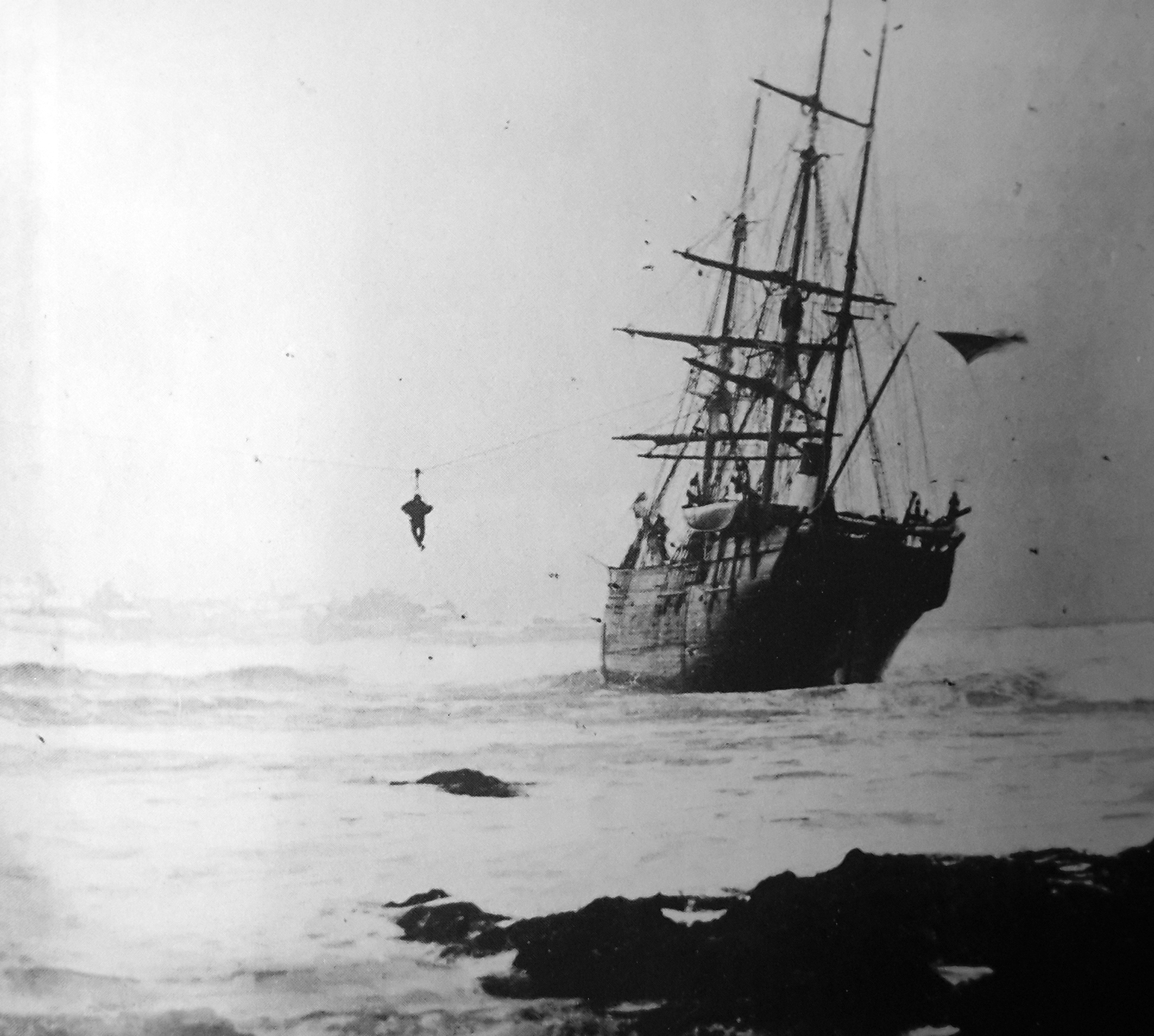
“Windward“, Built as a Sailing Whale Ship at the Stephen & Forbes Yard, Peterhead in 1860, was Fitted with Steam Engines along with the “Mazinthien” in 1865. Many Owners could not afford to have their Ships converted & Fleet numbers fell quickly. Aware of the success of John Gray’s ‘Mazinthien’ the Captain’s brother, David Gray III, had the Famous Ship ‘Eclipse‘ a Screw Steamer Built to his own Specifications in Aberdeen, the following year. ‘Hope‘ Sister Ship Eclipse 1867 Built by Alexander Hall & Co, Aberdeen for Captain David Gray, Master & Shipowner. Registered at Peterhead.
Steam Whaler Eclipse. It was Built to the Specifications of Captain David Gray III, in 1867 by the Alexander Hall Shipyard in Aberdeen & cost £12,000. Launched from Hall’s Yard on 3rd January 1867 it carried 8– Whaleboats and a Crew of 55-men. After a famous career at Peterhead the Ship was Sold to Dundee in 1893 and later on to Norway. Eclipse went Whaling from Peterhead for many years. It was finally sunk in 1941 during a German Air Raid on Archangelsk while working as a Russian Oceanographic Vessel renamed ‘Lomonosov‘.
LATONA 1813 ABERDEEN Lost in Davis Straits
EARL OF FYFFE 1816 BANFF Wrecked
ELBE 1818 ABERDEEN Lost
DIAMOND 1819 ABERDEEN Wrecked
ELIZABETH 1821 ABERDEEN
ALERT 1823 PETERHEAD Wrecked
DON 1825 ABERDEEN
JEAN 1826 PETERHEAD Wrecked. 46 crew transferred to the ‘Dundee’
DEXTERITY 1826 PETERHEAD Crushed in ice, crew spread amongst fleet
ENTERPRISE 1828 PETERHEAD Crushed
JANE 1829 Aberdeen Wrecked. Crew rescued
LAETITIA 1830 Aberdeen Wrecked Davis Straits
RESOLUTION 1830 Aberdeen Wrecked Davis Straits
ALEXANDER 1830 Aberdeen Wrecked, Davis Straits
HOPE 1830 PETERHEAD Wrecked, Davis Straits
RESOLUTION 1830 PETERHEAD Wrecked
JAMES 1831 PETERHEAD Crushed in Ice May 25th, Davis Straits
HENRIETTA 1834 Aberdeen Wrecked
HECLA 1840 PETERHEAD Lost in ice
RANGER 1843 PETERHEAD Wrecked
MARY 1849 Aberdeen Lost with all hands. A sealer
SUPERIOR 1849 PETERHEAD Crushed
JOSEPH GREEN 1852 PETERHEAD Wrecked
GIPSY 1857 PETERHEAD
UNDAUNTED 1857 PETERHEAD
ECLIPSE 1858 PETERHEAD
TRAVELLER 1858 PETERHEAD
INNUIT 1858 PETERHEAD Broke-up on Maiden Voyage
EMPRESS OF INDIA 1858 PETERHEAD Broke-up on Maiden Voyage
ST Andrew 1861 Aberdeen Lost with all hands
COMMERCE 1861 PETERHEAD Wrecked
ARCTIC 1862 Aberdeen Wrecked
RESOLUTION 1862 PETERHEAD Wrecked
PACIFIC 1863 Aberdeen Lost
Whale Fishery 1885 – This Season was been one of the most disastrous on record to the Whaling Vessels. Intelligence had already been received of the entire Destruction of 4 of these, of which we merely notified the fact a Fortnight ago: & rumour has it that others have shared a like Fate. These 4 are the Superior, 400-tonnes Burthen, belonging to Peterhead: the Lady Jane, 300-tonnes, Captain Paterson, of Newcastle; the Prince of Wales, 380-tons, of Hull; & a large American Ship – the whole crushed to pieces by Icebergs. The particulars are thus described: on the 12th of June, last 3 of the above-named Vessels were Fishing in Company with 8 other Vessels, in Melville Bay, Davis’ Straits. For days previous the Gales had been frequent & terrific & the Seas tempestuous in the extreme. About 11-am an Alarm was raised of the Floating Ice Setting in upon them. So suddenly did it bear down & with such force & immense Masses, that the Superior, the Lady Jane, & the American Ship McLellam, of New London, had not the slightest chance of escaping it & were speedily cut in pieces. The 1st Vessel Destroyed was the Superior & immediately afterwards the Lady Jane was literally cut in 2, the Masts at the same time falling Overboard & in less than 2-hrs not a vestige of the Ship was to be seen, so completely had the Ice covered her. From the time the Lady Jane was struck to the moment she Disappeared, the Crew, consisting of 50-Souls, succeeded in securing the 7-Boats belonging to the Ship, together with some Clothing & Provisions. As to the American Vessel, although dreadfully Shattered. The Crew, aided by those belonging to the Superior & Lady Jane, made an Effort to keep her Afloat. After remaining in the Ice till the 16th, & finding all attempts to save the Vessel abortive, the Provisions were divided & the Crews got the Boats ready & Launched them & at 7-pm with the wind North-east & Clear Weather, they sailed Southward along the edge of the Ice, sometimes having to encounter large Fields of Ice, which caused them to drag the Boats over it to gain the Open Sea. Captain Paterson’s Party made Land on the 19th, though the Weather was Thick & Foggy & after each Boat’s Crew had obtained refreshments they set Sail again & made for the nearest Danish Settlement, keeping the Land in View as they proceeded. Thus exposed to the Weather, sometimes Rowing, sometimes Sailing & contending with heavy Falls of Snow & Gales of Wind, they succeeded in gaining Opernawick in Greenland.
Leaving 2-Boats with their Crews, Captain Paterson proceeded with the other 5-Boats, all of whom reached Lively, another Settlement of the Danes, 500-miles from Melville Bay, on the 29th of June, where they were kindly received & every Hospitality shown them, as far as the means in possession of the Natives could afford. The unfortunate Crews of the other Vessels were, we are happy to say, equally successful; not a Life was Lost & they eventually gained the latterly named Settlement in safety, whence they were forwarded to the Orkney Islands by the 1st Vessel that touched at the Settlement. The Prince of Wales Whaler was Wrecked in another part of Davis’ Straits under precisely similar circumstances. She was caught by huge masses of Ice, cutting her up in a very short time, the Crew barely having time to save their Boats. They gained the Orkney Islands in Safety & have here now, we trust, reached their respective Homes. It is worthy of remark that 1 of the above Vessels was the Oldest Whaler in the Greenland Service – the Lady Jane; she had been Employed in the Fisheries nearly 70-yrs. The Destruction of the 4-Ships is computed at a Loss of nearly £50,000. – John O’Groat’s Journal. 9th February 1850.
‘Eely’ Betty – Female Character of Footdee who worked in the Whale Oil Yard
With Financial support from the Coats Family, Bruce had acquired a Norwegian Whaler, Hekla, which W S Bruce transformed into a fully equipped Antarctic Research Ship, renamed Scotia. Hekla was sailed across the North Sea to Aberdeen, then to Peterhead & Inverness & through the Caledonian Canal to Oban & finally Troon. The Naval Architect George Watson gave his Services free for the Refit of Hekla (to be renamed Scotia). Although the Ship had been Inspected by Fridtjof Nansen & by Colin Archer the Architect of Nansen’s own Ship, it proved to be in poor condition. The outer layers of Wood were good but below them the Wood was Rotten. Watson’s comment was: ‘Fill her with Stones & take her to Ailsa Craig and Sink her.’ Scotia was virtually Rebuilt & in her Final Form was one of the most graceful of Polar Ships. The Ship was fitted out in Ailsa Shipyard at Troon with new Spars & a New Engine. He then Appointed an all-Scottish Crew & Scientific Team. Scotia left Troon on 2nd November 1902 & headed South towards Antarctica, where Bruce intended to set up Winter Quarters in the Weddell Sea Quadrant, “as near to the South Pole as is practicable”. On 22nd February the Ship reached 70°-25′S, but could proceed no further because of Heavy Ice. She retreated to Laurie Island in the South Orkneys chain & Wintered there in a Bay he named Scotia Bay.
A Meteorological Station, Omond House (named after Robert Traill Omond), was Established as part of a full Programme of Scientific Work. In November 1903 Scotia retreated to Buenos Aires for repair & re-provisioning. While in Argentina, Bruce negotiated an Agreement with the Government whereby Omond House became a permanent Weather Station, under Argentinian control. Renamed Orcadas Base, the Site has been continuously in Operation since then & provides the longest historical Meteorological Series of Antarctica. In January 1904 Scotia sailed South again, to explore the Weddell Sea. On 6th March, new Land was sighted, part of the Sea’s Eastern Boundary; Bruce named this Coats Land after the Expedition’s Chief Backers. On 14th March, at 74°-01′S & in danger of becoming Icebound, Scotia turned North. The long Voyage back to Scotland, via Cape Town, was Completed on 21st July 1904. This Expedition assembled a large collection of animal, marine & plant specimens & carried out extensive Hydrographic, Magnetic & Meteorological Observations. 100-Years later it was recognised that the Expedition’s work had “laid the Foundation of modern Climate Change Studies” & that its Experimental work had showed this part of the Globe to be crucially important to the World’s Climate. According to the Oceanographer Tony Rice, it fulfilled a more comprehensive Programme than any other Antarctic Expedition of its day. At the time its reception in Britain was relatively muted; although its work was highly praised within sections of the Scientific Community, Bruce struggled to raise the Funding to Publish his Scientific Results, and blamed Markham for the lack of National Recognition.
Scotia’s Hull – Minimum thickness 63cm (25 inches) of Wood – at the Bow it was Solid Wood 2.75M (9-ft) thick – with a layer of 5.7cm (2.25 ins) of Greenheart Sheathing, a very hard Tropical Hardwood, to protect it from Scraping by the Ice. These Timbers gave the sides of the Scotia a minimum thickness of 63-cm (25-ins) Amidships. These were required to enable the Ship to withstand the impact & pressure of Pack Ice. The Pressure of the Ice would eventually lift the Ship on to the Surface rather than Crushing it.
Engine – 55-HP Steam Engine.
Speed – Cruising Speed of 6-Knots burning 3-Tons of Coal a day, although the Ship could travel at up to 10-Knots under Sail if the was Wind favourable.
Deckhouse – 2-Laboratories for Microscopic Work & Zoology, plus a Photographic Dark Room, a Hazardous Cargo of 1,000-gals of Methylated Spirits were carried for preserving Specimens for Zoological Research.
Cabins – Officers & Scientists had Cabins off the Main Saloon as on Discovery. Mates & Petty Officers lived Amidships & the Crew in the Forward part of the Ship. The Dining Room was occasionally required for purposes other than eating.
In the Spring of 1905, after her success on the 1902-1904 Scottish National Antarctic Expedition under the Leadership of William S Bruce, the Exploration Ship Scotia was Sold for £5,019-0s-9d to a Dundee Consortium, which intended to return the Vessel to its original purpose of Whaling.
